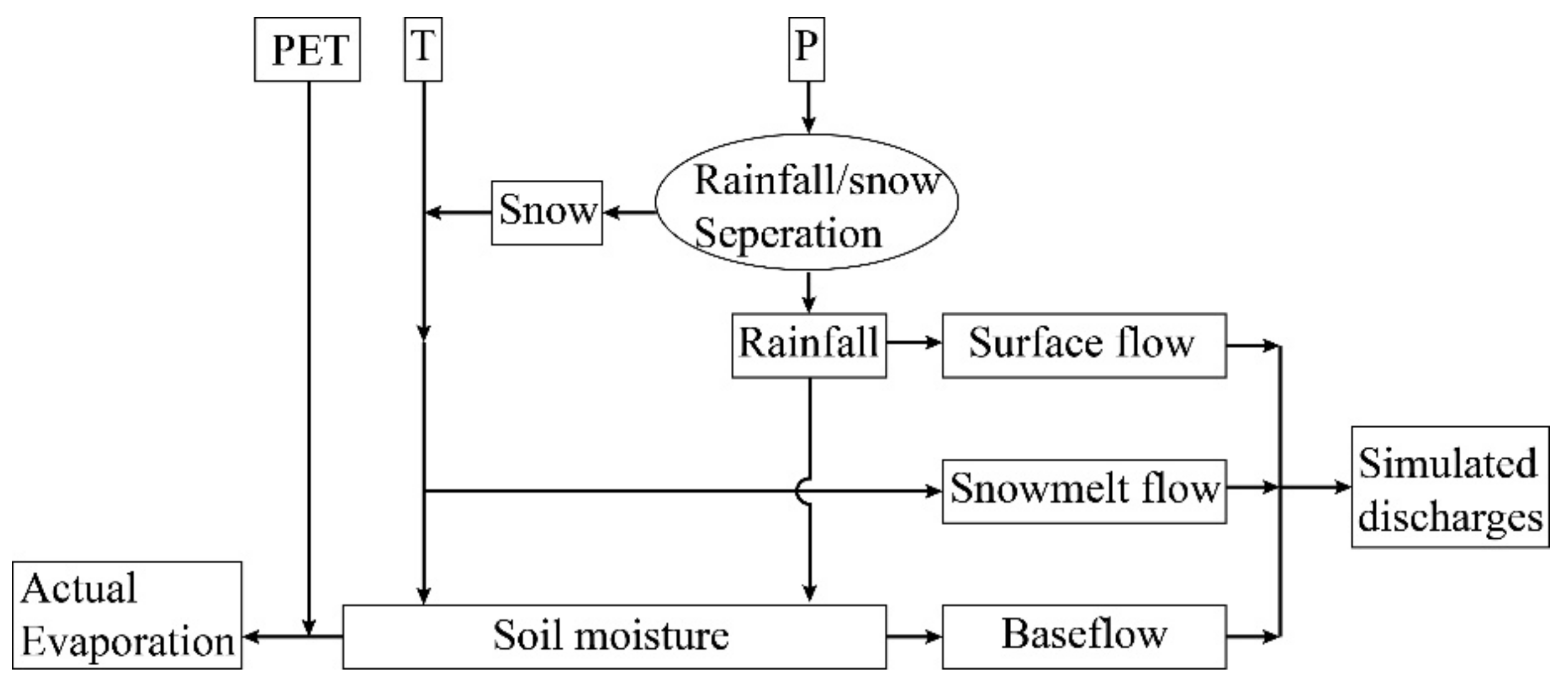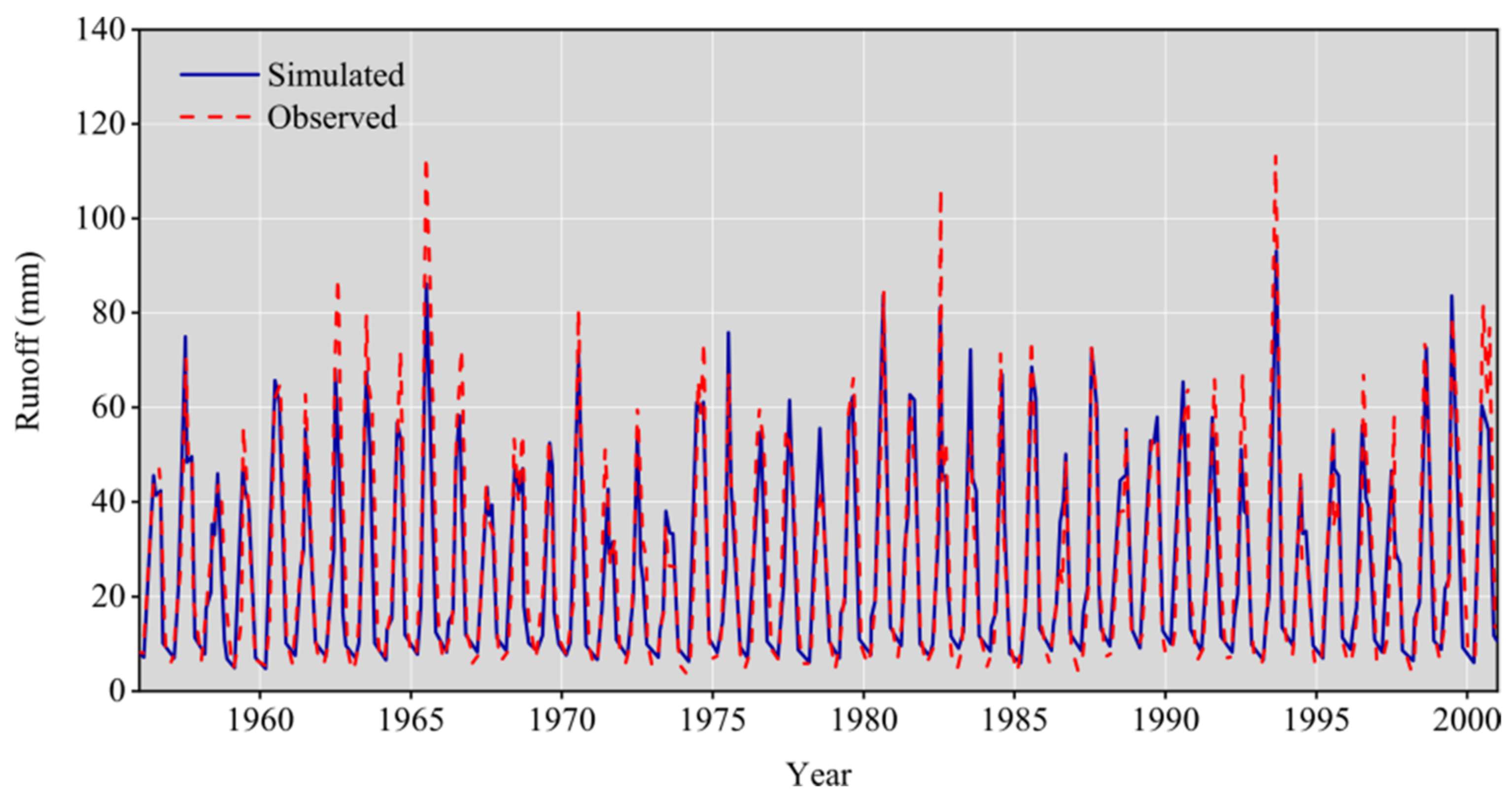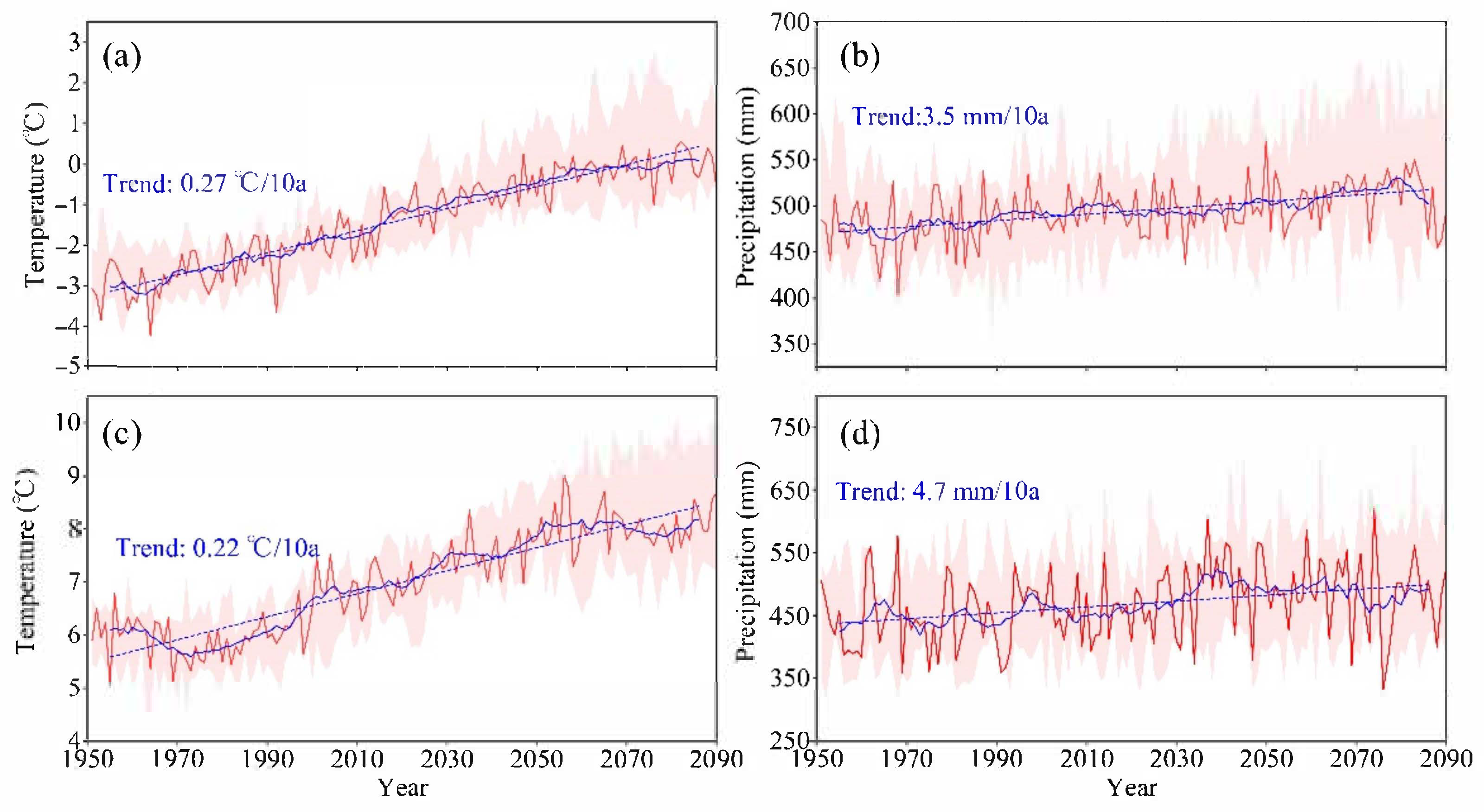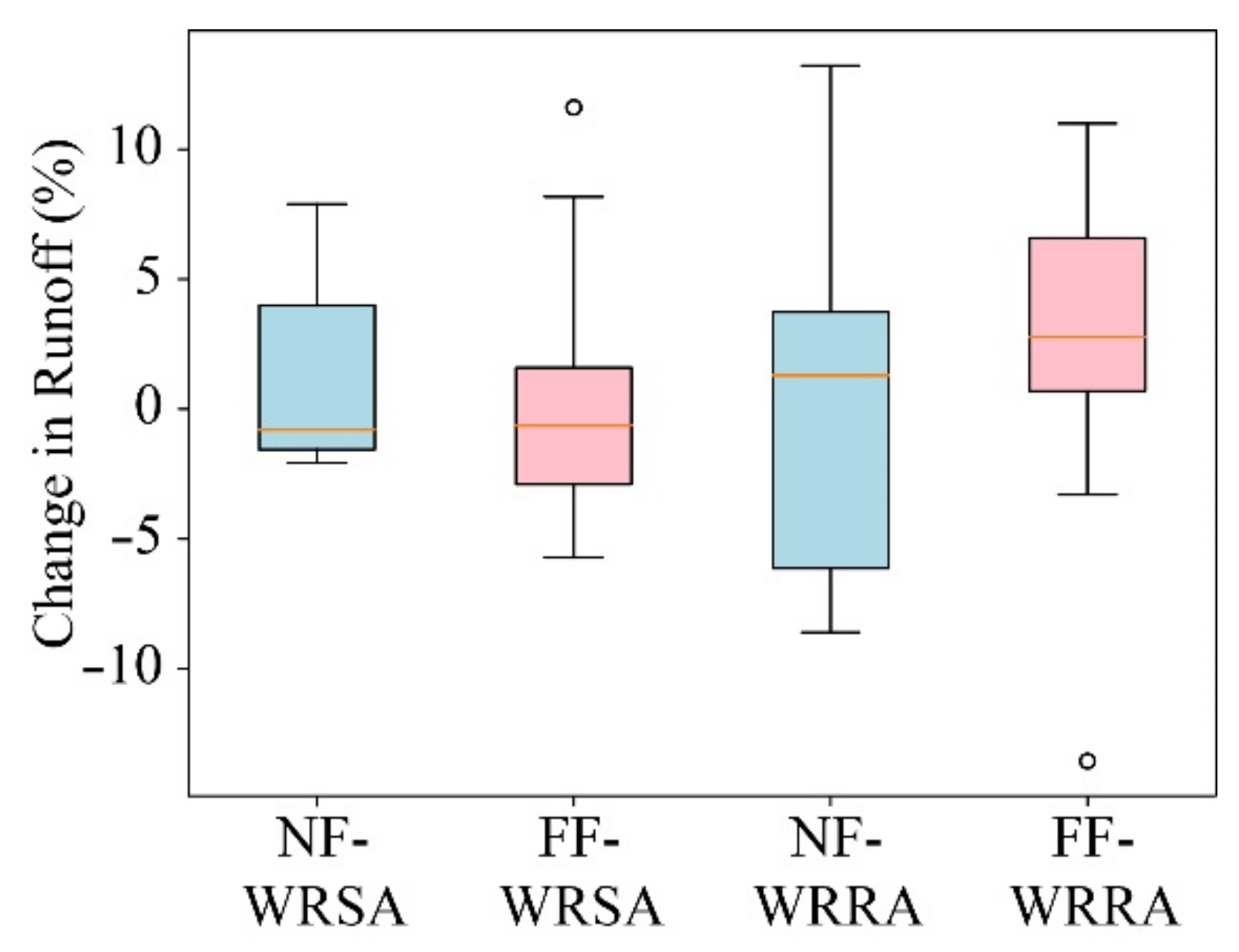Impact of Climate Change on Water Resources in the Western Route Areas of the South-to-North Water Diversion Project
Abstract
1. Introduction
2. Materials and Methods
2.1. Study Area
2.2. Hydrological Model
2.3. Data Sources
3. Results
3.1. Model Calibration
3.2. Changes in Temperature and Precipitation in Western Route
3.3. Changes in Streamflow in the Western Route
4. Discussion
4.1. Variations of Temperature, Precipitation and Streamflow in Western Route
4.2. Uncertainty
4.3. Limitations
5. Conclusions
- (1)
- Temperature will increase by 1.66 °C [1.27 °C, 1.92 °C] and 1.57 °C [1.37 °C, 1.64 °C] during 2025–2045 relative to the baseline period (1956–2000) in the western route source area and receiving area, respectively; during the far future (2040–2060) the increase will be 2.09 °C [1.64 °C, 3.09 °C] and 1.93 °C [1.82 °C, 2.64 °C], respectively.
- (2)
- Precipitation will very likely increase for the western route although the GCM projections are quite dispersed and uncertain, which will be beneficial to the operation of the SNWDP.
- (3)
- Grid-based RCCC-WBM performs well for streamflow simulations for the study areas. The median streamflow simulations among the nine GCMs will likely increase by less than 3% relative to the baseline for the western route.
- (4)
- Climate change will support the planning of the western route to a certain extent; however, the risk to the water supply caused by climate change in the plan and operation of the western route still require sufficient attention.
Author Contributions
Funding
Institutional Review Board Statement
Informed Consent Statement
Data Availability Statement
Acknowledgments
Conflicts of Interest
References
- Lu, Y.; Jiang, S.; Ren, L.; Zhang, L.; Wang, M.; Liu, R.; Wei, L. Spatial and Temporal Variability in Precipitation Concentration over Mainland China, 1961–2017. Water 2019, 11, 881. [Google Scholar] [CrossRef]
- Shu, Z.; Zhang, J.; Jin, J.; Wang, G.; Wang, L.; Cao, M. Evolution Characters and Causes of the Dry Season Runoff for the Major Rivers in China during 1961–2018. Adv. Clim. Chang. Res. 2021, 17, 340. [Google Scholar] [CrossRef]
- Wu, L.; Liu, X.; Ma, X. Spatio-Temporal Evolutions of Precipitation in the Yellow River Basin of China from 1981 to 2013. Water Supply 2016, 16, 1441–1450. [Google Scholar] [CrossRef]
- Yan, D.; Han, D.; Wang, G.; Yuan, Y.; Hu, Y.; Fang, H. The Evolution Analysis of Flood and Drought in Huai River Basin of China Based on Monthly Precipitation Characteristics. Nat. Hazards 2014, 73, 849–858. [Google Scholar] [CrossRef]
- Wang, G.; Zhang, J.; Li, Y.; Bao, Z.; Jin, J.; Yan, X.; Liu, C. Variation Trend of Future Climate for the Hai River Basin Based on Multiple GCMs Projections. Resour. Sci. 2014, 36, 1043–1050. [Google Scholar]
- Ling, M.; Han, H.; Wei, X.; Lv, C. Temporal and Spatial Distributions of Precipitation on the Huang-Huai-Hai Plain during 1960–2019, China. J. Water Clim. Chang. 2021, 12, 2232–2244. [Google Scholar] [CrossRef]
- Li, Y.; Xie, Z.; Qin, Y.; Zhou, S. Spatio-Temporal Variations in Precipitation on the Huang-Huai-Hai Plain from 1963 to 2012. J. Earth Syst. Sci. 2018, 127, 101. [Google Scholar] [CrossRef]
- Liu, Y.; Zhang, J.; Wang, G.; Wang, G.; Jin, J.; Liu, C.; Wan, S.; He, R. How Do Natural Climate Variability, Anthropogenic Climate and Basin Underlying Surface Change Affect Streamflows? A Three-Source Attribution Framework and Application. J. Hydro-Environ. Res. 2020, 28, 57–66. [Google Scholar] [CrossRef]
- CREEI. Water Resources Assessment and Its Development & Utilization in China; China Hydropower Press: Beijing, China, 2014. [Google Scholar]
- Zhang, Q. The South-to-North Water Transfer Project of China: Environmental Implications and Monitoring Strategy. J. Am. Water Resour. Assoc. 2009, 45, 1238–1247. [Google Scholar] [CrossRef]
- Wang, G.; Zhang, J.; Jin, J.; Pagano, T.; Bao, Z.; Liu, C.; Liu, Y.; Yan, X. Assessing Water Resources in China Using PRECIS Projections and a VIC Model. Hydrol. Earth Syst. Sci. 2012, 16, 231–240. [Google Scholar] [CrossRef]
- Fang, G.; Zhu, X.; Huang, X. Risk Analysis of Floodwater Resources Utilization along Water Diversion Project: A Case Study of the Eastern Route of the South-to-North Water Diversion Project in China. Water Supply 2019, 19, 2464–2475. [Google Scholar] [CrossRef]
- Han, B.; Meng, N.; Zhang, J.; Cai, W.; Wu, T.; Kong, L.; Ouyang, Z. Assessment and Management of Pressure on Water Quality Protection along the Middle Route of the South-to-North Water Diversion Project. Sustainability 2019, 11, 3087. [Google Scholar] [CrossRef]
- Zhang, J.; Ma, X.; Jing, L.; Yang, L. Plan optimization of the west route of South-to-North Water Diversion Project. South-to-North Water Transf. Water Sci. Technol. 2020, 18, 109–114. [Google Scholar] [CrossRef]
- Liu, X.; Liu, C.; Luo, Y.; Zhang, M.; Xia, J. Dramatic Decrease in Streamflow from the Headwater Source in the Central Route of China’s Water Diversion Project: Climatic Variation or Human Influence? J. Geophys. Res. Atmos. 2012, 117, D06113. [Google Scholar] [CrossRef]
- Yan, B.; Chen, L. Coincidence Probability of Precipitation for the Middle Route of South-to-North Water Transfer Project in China. J. Hydrol. 2013, 499, 19–26. [Google Scholar] [CrossRef]
- Yang, S.; Xu, K.; Milliman, J.; Yang, H.; Wu, C. Decline of Yangtze River Water and Sediment Discharge: Impact from Natural and Anthropogenic Changes. Sci. Rep. 2015, 5, 12581. [Google Scholar] [CrossRef]
- Yang, S.L.; Shi, B.; Fan, J.; Luo, X.; Tian, Q.; Yang, H.; Chen, S.; Zhang, Y.; Zhang, S.; Shi, X. Streamflow Decline in the Yellow River along with Socioeconomic Development: Past and Future. Water 2020, 12, 823. [Google Scholar] [CrossRef]
- Yin, Y.; Wang, L.; Wang, Z.; Tang, Q.; Piao, S.; Chen, D.; Xia, J.; Conradt, T.; Liu, J.; Wada, Y. Quantifying Water Scarcity in Northern China within the Context of Climatic and Societal Changes and South-to-North Water Diversion. Earths Future 2020, 8, e2020EF001492. [Google Scholar] [CrossRef]
- Wang, G.; Zhang, J.; He, R.; Liu, C.; Ma, T.; Bao, Z.; Liu, Y. Runoff Sensitivity to Climate Change for Hydro-Climatically Different Catchments in China. Stoch. Environ. Res. Risk Assess. 2017, 31, 1011–1021. [Google Scholar] [CrossRef]
- Guan, X.; Zhang, J.; Elmahdi, A.; Li, X.; Liu, J.; Liu, Y.; Jin, J.; Liu, Y.; Bao, Z.; Liu, C. The Capacity of the Hydrological Modeling for Water Resource Assessment under the Changing Environment in Semi-Arid River Basins in China. Water 2019, 11, 1328. [Google Scholar] [CrossRef]
- Ning, Z.; Zhang, J.; Wang, G. Variation and Global Pattern of Major Meteorological Elements during 1948–2016. China Environ. Sci. 2021, 41, 4085–4095. [Google Scholar] [CrossRef]
- Shi, X.; Qin, T.; Nie, H.; Weng, B.; He, S. Changes in Major Global River Discharges Directed into the Ocean. Int. J. Environ. Res. Public Health 2019, 16, 1469. [Google Scholar] [CrossRef]
- Zhang, L.; Qin, L.; Yang, Z.; Xia, J.; Zeng, S. Climate Change Impacts on Hydrological Processes in the Water Source Area of the Middle Route of the South-to-North Water Diversion Project. Water Int. 2012, 37, 564–584. [Google Scholar] [CrossRef]
- Luo, Y.; Qin, N.; Zhou, B.; Li, J.; Liu, J.; Wang, C.; Pang, T. Change of Runoff in the Source Region of the Yangtze River from 1961 to 2016. Res. Soil Water Conserv. 2019, 26, 123–128. [Google Scholar] [CrossRef]
- Zheng, Y.; Huang, Y.; Zhou, S.; Wang, K.; Wang, G. Effect Partition of Climate and Catchment Changes on Runoff Variation at the Headwater Region of the Yellow River Based on the Budyko Complementary Relationship. Sci. Total Environ. 2018, 643, 1166–1177. [Google Scholar] [CrossRef]
- Tian, S.; Xu, M.; Jiang, E.; Wang, G.; Hu, H.; Liu, X. Temporal Variations of Runoff and Sediment Load in the Upper Yellow River, China. J. Hydrol. 2019, 568, 46–56. [Google Scholar] [CrossRef]
- Wu, J.; Miao, C.; Wang, Y.; Duan, Q.; Zhang, X. Contribution Analysis of the Long-Term Changes in Seasonal Runoff on the Loess Plateau, China, Using Eight Budyko-Based Methods. J. Hydrol. 2017, 545, 263–275. [Google Scholar] [CrossRef]
- Guan, X.; Zhang, J.; Bao, Z.; Liu, C.; Jin, J.; Wang, G. Past Variations and Future Projection of Runoff in Typical Basins in 10 Water Zones, China. Sci. Total Environ. 2021, 798, 149277. [Google Scholar] [CrossRef]
- Wang, G.; Zhang, J.; Guan, X.; Bao, Z.; Liu, Y.; He, R.; Jin, J.; Liu, C.; Chen, X. Quantifying Attribution of Runoff Change for Major Rivers in China. Adv. Water Sci. 2020, 31, 313–323. [Google Scholar] [CrossRef]
- Qiao, C.; Ning, Z.; Wang, Y.; Sun, J.; Lin, Q.; Wang, G. Impact of Climate Change on Water Availability in Water Source Areas of the South-to-North Water Diversion Project in China. Front. Earth Sci. 2021, 9, 747429. [Google Scholar] [CrossRef]
- Stouffer, R.J.; Eyring, V.; Meehl, G.A.; Bony, S.; Senior, C.; Stevens, B.; Taylor, K.E. Cmip5 Scientific Gaps and Recommendations for Cmip6. Bull. Amer. Meteorol. Soc. 2017, 98, 95. [Google Scholar] [CrossRef]
- Zhang, S.; Chen, J. Uncertainty in Projection of Climate Extremes: A Comparison of CMIP5 and CMIP6. J. Meteorol. Res. 2021, 35, 646–662. [Google Scholar] [CrossRef]
- Song, Z.; Xia, J.; She, D.; Li, L.; Hu, C.; Hong, S. Assessment of Meteorological Drought Change in the 21st Century Based on CMIP6 Multi-Model Ensemble Projections over Mainland China. J. Hydrol. 2021, 601, 126643. [Google Scholar] [CrossRef]
- Zhu, H.; Jiang, Z.; Li, L. Projection of Climate Extremes in China, an Incremental Exercise from CMIP5 to CMIP6. Sci. Bull. 2021, 66, 2528–2537. [Google Scholar] [CrossRef]
- Wang, G.; Zhang, J.; Xuan, Y.; Liu, J.; Jin, J.; Bao, Z.; He, R.; Liu, C.; Liu, Y.; Yan, X. Simulating the Impact of Climate Change on Runoff in a Typical River Catchment of the Loess Plateau, China. J. Hydrometeorol. 2013, 14, 1553–1561. [Google Scholar] [CrossRef]
- Schewe, J.; Heinke, J.; Gerten, D.; Haddeland, I.; Arnell, N.W.; Clark, D.B.; Dankers, R.; Eisner, S.; Fekete, B.M.; Colón-González, F.J. Multimodel Assessment of Water Scarcity under Climate Change. Proc. Natl. Acad. Sci. USA 2014, 111, 3245–3250. [Google Scholar] [CrossRef]
- Bao, Z.; Zhang, J.; Yan, X.; Wang, G.; Jin, J.; Liu, Y.; Guan, X. Future Streamflow Assessment in the Haihe River Basin Located in Northern China Using a Regionalized Variable Infiltration Capacity Model Based on 18 CMIP5 GCMs. J. Water Clim. Chang. 2020, 11, 1551–1569. [Google Scholar] [CrossRef]
- Zhang, Y.; Su, F.; Hao, Z.; Xu, C.; Yu, Z.; Wang, L.; Tong, K. Impact of Projected Climate Change on the Hydrology in the Headwaters of the Yellow River Basin. Hydrol. Process. 2015, 29, 4379–4397. [Google Scholar] [CrossRef]
- Wang, Y.; Yancg, X.; Zhang, M.; Zhang, L.; Yu, X.; Ren, L.; Liu, Y.; Jiang, S.; Yuan, F. Projected Effects of Climate Change on Future Hydrological Regimes in the Upper Yangtze River Basin, China. Adv. Meteorol. 2019, 2019, 1545746. [Google Scholar] [CrossRef]
- Su, B.; Huang, J.; Zeng, X.; Gao, C.; Jiang, T. Impacts of Climate Change on Streamflow in the Upper Yangtze River Basin. Clim. Chang. 2017, 141, 533–546. [Google Scholar] [CrossRef]
- Qin, P.; Liu, M.; Du, L.; Xu, H.; Liu, L.; Xiao, C. Climate Change Impact Ob Runoff in the Upper Yangtze River Basin. Adv. Clim. Chang. Res. 2019, 15, 405–415. [Google Scholar]
- Huang, J.; Wang, Y.; Su, B.; Zhai, J. Future Climate Change and Its Impact on Runoff in the Upper Reach of Yangtze River under RCP4.5 Scenario. Meteorol. Mon. 2016, 42, 614–620. [Google Scholar]
- Su, F.; Zhang, L.; Ou, T.; Chen, D.; Yao, T.; Tong, K.; Qi, Y. Hydrological Response to Future Climate Changes for the Major Upstream River Basins in the Tibetan Plateau. Glob. Planet. Chang. 2016, 136, 82–95. [Google Scholar] [CrossRef]
- Wang, Y.; Liao, W.; Ding, Y.; Wang, X.; Jiang, Y.; Song, X.; Lei, X. Water Resource Spatiotemporal Pattern Evaluation of the Upstream Yangtze River Corresponding to Climate Changes. Quat. Int. 2015, 380, 187–196. [Google Scholar] [CrossRef]
- Guan, X.; Zhang, J.; Yang, Q.; Tang, X.; Liu, C.; Jin, J.; Liu, Y.; Bao, Z.; Wang, G. Evaluation of Precipitation Products by Using Multiple Hydrological Models over the Upper Yellow River Basin, China. Remote Sens. 2020, 12, 4023. [Google Scholar] [CrossRef]
- Wang, G.; Zhang, J.; Jin, J.; Liu, Y.; He, R.; Bao, Z.; Liu, C.; Li, Y. Regional Calibration of a Water Balance Model for Estimating Stream Flow in Ungauged Areas of the Yellow River Basin. Quat. Int. 2014, 336, 65–72. [Google Scholar] [CrossRef]
- Kraaijenbrink, P.D.; Stigter, E.E.; Yao, T.; Immerzeel, W.W. Climate Change Decisive for Asia’s Snow Meltwater Supply. Nat. Clim. Chang. 2021, 11, 591–597. [Google Scholar] [CrossRef]
- Wu, J.; Gao, X. A Gridded Daily Observation Dataset over China Region and Comparison with the Other Datasets. Chin. J. Geophys. 2013, 56, 1102–1111. [Google Scholar] [CrossRef]
- Wu, J.; Gao, X.; Giorgi, F.; Chen, D. Changes of Effective Temperature and Cold/Hot Days in Late Decades over China Based on a High Resolution Gridded Observation Dataset. Int. J. Climatol. 2017, 37, 788–800. [Google Scholar] [CrossRef]
- Xu, Y.; Gao, X.; Shen, Y.; Xu, C.; Shi, Y.; Giorgi, F. A Daily Temperature Dataset over China and Its Application in Validating a RCM Simulation. Adv. Atmos. Sci. 2009, 26, 763–772. [Google Scholar] [CrossRef]
- Song, Y.H.; Chung, E.-S.; Shahid, S. Spatiotemporal Differences and Uncertainties in Projections of Precipitation and Temperature in South Korea from CMIP6 and CMIP5 General Circulation Models. Int. J. Climatol. 2021, 41, 5899–5919. [Google Scholar] [CrossRef]
- You, Q.; Cai, Z.; Wu, F.; Jiang, Z.; Pepin, N.; Shen, S.S.P. Temperature Dataset of CMIP6 Models over China: Evaluation, Trend and Uncertainty. Clim. Dyn. 2021, 57, 17–35. [Google Scholar] [CrossRef]
- Wang, L.; Zhang, J.; Shu, Z.; Wang, Y.; Bao, Z.; Liu, C.; Zhou, X.; Wang, G. Evaluation of the Ability of CMIP6 Global Climate Models to Simulate Precipitation in the Yellow River Basin, China. Front. Earth Sci. 2021, 9, 751974. [Google Scholar] [CrossRef]
- Fang, G.; Yang, J.; Chen, Y.; Li, Z.; De Maeyer, P. Impact of GCM Structure Uncertainty on Hydrological Processes in an Arid Area of China. Hydrol. Res. 2018, 49, 893–907. [Google Scholar] [CrossRef]
- Yang, X.; Zheng, W.; Ren, L.; Zhang, M.; Wang, Y.; Liu, Y.; Yuan, F.; Jiang, S. Potential Impact of Climate Change to the Future Streamflow of Yellow River Basin Based on CMIP5 Data. Proc. IAHS 2018, 376, 97–104. [Google Scholar] [CrossRef][Green Version]
- Hassan, Z.; Shamsudin, S.; Harun, S. Application of SDSM and LARS-WG for Simulating and Downscaling of Rainfall and Temperature. Theor. Appl. Climatol. 2014, 116, 243–257. [Google Scholar] [CrossRef]
- IPCC. Climate Change 2021: The Pysical Science Basis; Cambridge University Press: Cambridge, UK, 2021. [Google Scholar]
- Labat, D.; Godderis, Y.; Probst, J.L.; Guyot, J.L. Evidence for Global Runoff Increase Related to Climate Warming. Adv. Water Resour. 2004, 27, 631–642. [Google Scholar] [CrossRef]
- Liu, J.; Wang, J.; Jiao, M.; Zhang, R. Response of Water Resources in the Yellow River Basinto Global Climate Change. Arid Zone Res. 2011, 28, 860–865. [Google Scholar] [CrossRef]
- Wang, G.; Qiao, C.; Liu, M.; Du, F.; Ye, T.; Wang, J. The future water resources regime of the Yellow River basin in the context of climate change. Hydro-Sci. Eng. 2020, 2, 1–8. [Google Scholar] [CrossRef]
- Yan, Z.; Zhou, Z.; Liu, J.; Wang, H.; Li, D. Water Use Characteristics and Impact Factors in the Yellow River Basin, China. Water Int. 2020, 45, 148–168. [Google Scholar] [CrossRef]
- Chen, J.; He, D.; Cui, S. The Response of River Water Quality and Quantity to the Development of Irrigated Agriculture in the Last 4 Decades in the Yellow River Basin, China. Water Resour. Res. 2003, 39, WR01234. [Google Scholar] [CrossRef]
- Peng, S.; Zheng, X.; Wang, Y.; Jiang, G. Study on Water-Energy-Food Collaborative Optimization for Yellow River Basin. Adv. Water Sci. 2017, 28, 681–690. [Google Scholar] [CrossRef]
- Zhang, J.; Chen, L.; Li, B.; Xu, W. Research on the precipitation of precipitation change with in Upper Yangtze River Basin during 2011–2060. Water Resour. Hydropower Eng. 2012, 43, 4–9. [Google Scholar] [CrossRef]
- Yang, X.; Yu, X.; Wang, Y.; Liu, Y.; Zhang, M.; Ren, L.; Yuan, F.; Jiang, S. Estimating the Response of Hydrological Regimes to Future Projections of Precipitation and Temperature over the Upper Yangtze River. Atmos. Res. 2019, 230, 104627. [Google Scholar] [CrossRef]
- Zhao, Q.; Ding, Y.; Wang, J.; Gao, H.; Zhang, S.; Zhao, C.; Xu, J.; Han, H.; Shangguan, D. Projecting Climate Change Impacts on Hydrological Processes on the Tibetan Plateau with Model Calibration against the Glacier Inventory Data and Observed Streamflow. J. Hydrol. 2019, 573, 60–81. [Google Scholar] [CrossRef]
- Xu, W.; Chen, J.; Gu, L.; Zhu, B.; Zhuan, M. Runoff Response to 1.5 °C and 2.0 °C Global Warming for the Yangtze River Basin. Adv. Clim. Chang. Res. 2020, 16, 690–705. [Google Scholar]
- Li, K. Study on the Evolution Law and Future Trend of Runoff in the Three-River Headwater Region; Changjiang River Scientific Research Institute: Wuhan, China, 2021. [Google Scholar]
- Mujumdar, P.P.; Ghosh, S. Modeling GCM and Scenario Uncertainty Using a Possibilistic Approach: Application to the Mahanadi River, India. Water Resour. Res. 2008, 44, W06407. [Google Scholar] [CrossRef]
- Gao, J.; Sheshukov, A.Y.; Yen, H.; Douglas-Mankin, K.R.; White, M.J.; Arnold, J.G. Uncertainty of Hydrologic Processes Caused by Bias-Corrected CMIP5 Climate Change Projections with Alternative Historical Data Sources. J. Hydrol. 2019, 568, 551–561. [Google Scholar] [CrossRef]
- Janzwood, S. Confident, Likely, or Both? The Implementation of the Uncertainty Language Framework in IPCC Special Reports. Clim. Chang. 2020, 162, 1655–1675. [Google Scholar] [CrossRef]
- Vetter, T.; Reinhardt, J.; Floerke, M.; van Griensven, A.; Hattermann, F.; Huang, S.; Koch, H.; Pechlivanidis, I.G.; Ploetner, S.; Seidou, O.; et al. Evaluation of Sources of Uncertainty in Projected Hydrological Changes under Climate Change in 12 Large-Scale River Basins. Clim. Chang. 2017, 141, 419–433. [Google Scholar] [CrossRef]
- Bao, X.; Zhang, F. Evaluation of NCEP-CFSR, NCEP-NCAR, ERA-Interim, and ERA-40 Reanalysis Datasets against Independent Sounding Observations over the Tibetan Plateau. J. Clim. 2013, 26, 206–214. [Google Scholar] [CrossRef]
- Korkanc, S.Y. Impacts of Recreational Human Trampling on Selected Soil and Vegetation Properties of Aladag Natural Park, Turkey. Catena 2014, 113, 219–225. [Google Scholar] [CrossRef]
- Ren, Z.; Zhu, L.; Wang, B.; Cheng, S. Soil Hydraulic Conductivity as Affected by Vegetation Restoration Age on the Loess Plateau, China. J. Arid Land 2016, 8, 546–555. [Google Scholar] [CrossRef]
- Wang, H.; Sun, F. Variability of Annual Sediment Load and Runoff in the Yellow River for the Last 100 Years (1919-2018). Sci. Total Environ. 2021, 758, 143715. [Google Scholar] [CrossRef]
- Jiang, W.; Yuan, L.; Wang, W.; Cao, R.; Zhang, Y.; Shen, W. Spatio-Temporal Analysis of Vegetation Variation in the Yellow River Basin. Ecol. Indic. 2015, 51, 117–126. [Google Scholar] [CrossRef]
- Xu, X.; Yang, D.; Yang, H.; Lei, H. Attribution Analysis Based on the Budyko Hypothesis for Detecting the Dominant Cause of Runoff Decline in Haihe Basin. J. Hydrol. 2014, 510, 530–540. [Google Scholar] [CrossRef]
- Poulin, A.; Brissette, F.; Leconte, R.; Arsenault, R.; Malo, J.-S. Uncertainty of Hydrological Modelling in Climate Change Impact Studies in a Canadian, Snow-Dominated River Basin. J. Hydrol. 2011, 409, 626–636. [Google Scholar] [CrossRef]
- Zhang, L.; Su, F.; Yang, D.; Hao, Z.; Tong, K. Discharge Regime and Simulation for the Upstream of Major Rivers over Tibetan Plateau. J. Geophys. Res. Atmos. 2013, 118, 8500–8518. [Google Scholar] [CrossRef]
- Mukhopadhyay, B.; Khan, A. A Reevaluation of the Snowmelt and Glacial Melt in River Flows within Upper Indus Basin and Its Significance in a Changing Climate. J. Hydrol. 2015, 527, 119–132. [Google Scholar] [CrossRef]
- Chu, D. Spatiotemporal Variability of Snow Cover on Tibet, China Using MODIS Remote-Sensing Data. Int. J. Remote Sens. 2018, 39, 6784–6804. [Google Scholar] [CrossRef]
- Yi, S.; Song, C.; Heki, K.; Kang, S.; Wang, Q.; Chang, L. Satellite-Observed Monthly Glacier and Snow Mass Changes in Southeast Tibet: Implication for Substantial Meltwater Contribution to the Brahmaputra. Cryosphere 2020, 14, 2267–2281. [Google Scholar] [CrossRef]
- Grigg, N.S. Large-Scale Water Development in the United States: TVA and the California State Water Project. Int. J. Water Resour. Dev. 2021, 1–19, Online. [Google Scholar] [CrossRef]
- Ren, S.; Kingsford, R.T. Modelling Impacts of Regulation on Flows to the Lowbidgee Floodplain of the Murrumbidgee River, Australia. J. Hydrol. 2014, 519, 1660–1667. [Google Scholar] [CrossRef]







| Parameters | Description | Unit | Prior Range |
|---|---|---|---|
| Ks | Surface flow coefficient | - | (0, 1) |
| Kg | Baseflow coefficient | - | (0, 1) |
| Ksn | Snowmelt flow coefficient | - | (0, 1) |
| Smax | Maximum soil moisture store | mm | (0, 400) |
| Nos. | GCMs | Country and Developer | Resolution | Nos. | GCMs | Country and Developer | Resolution |
|---|---|---|---|---|---|---|---|
| 1 | BCC-CSM2 | China, BCC | 1.25° × 1.25° | 6 | FIO-ESM | China, FIO | 2.8° × 2.8° |
| 2 | CNRM-CM6 | France, CNRM-CERFACS | 1.4° × 1.4° | 7 | GFDL-ESM4 | America, GFDL | 1.25° × 1° |
| 3 | CSIRO-MK-3 | Australia, CSIRO | 1.9° × 1.9° | 8 | GISS-E2-H | America, GISS | 2.0° × 2.5° |
| 4 | FGOALS-G3 | China, LASG-CESS | 2.0° × 2.25° | 9 | MIROC-ES2L | Japan, CCSR/NIES/FRCGC | 2.8° × 2.8° |
| 5 | CCSM4 | America, NCAR | 1.25° × 0.9° |
| Areas | Stations | Model Calibration | Model Validation | ||||
|---|---|---|---|---|---|---|---|
| Data Series | NSE(%) | Re(%) | Data Series | NSE(%) | Re(%) | ||
| Source area | Dajin | 1957–1989 | 83.7 | −1.1 | 1990–2000 | 85.1 | −0.2 |
| Yajiang | 1956–1989 | 86.6 | −1.9 | 1990–2000 | 89.3 | 2.1 | |
| Batang | 1960–1989 | 83.3 | 0.4 | 1990–2000 | 74.6 | −0.7 | |
| Receiving area | Lijin | 1956–1989 | 80.6 | 1.5 | 1990–2000 | 76.2 | 0.4 |
Publisher’s Note: MDPI stays neutral with regard to jurisdictional claims in published maps and institutional affiliations. |
© 2022 by the authors. Licensee MDPI, Basel, Switzerland. This article is an open access article distributed under the terms and conditions of the Creative Commons Attribution (CC BY) license (https://creativecommons.org/licenses/by/4.0/).
Share and Cite
Ning, Z.; Zhang, J.; Yuan, S.; Wang, G. Impact of Climate Change on Water Resources in the Western Route Areas of the South-to-North Water Diversion Project. Atmosphere 2022, 13, 799. https://doi.org/10.3390/atmos13050799
Ning Z, Zhang J, Yuan S, Wang G. Impact of Climate Change on Water Resources in the Western Route Areas of the South-to-North Water Diversion Project. Atmosphere. 2022; 13(5):799. https://doi.org/10.3390/atmos13050799
Chicago/Turabian StyleNing, Zhongrui, Jianyun Zhang, Shanshui Yuan, and Guoqing Wang. 2022. "Impact of Climate Change on Water Resources in the Western Route Areas of the South-to-North Water Diversion Project" Atmosphere 13, no. 5: 799. https://doi.org/10.3390/atmos13050799
APA StyleNing, Z., Zhang, J., Yuan, S., & Wang, G. (2022). Impact of Climate Change on Water Resources in the Western Route Areas of the South-to-North Water Diversion Project. Atmosphere, 13(5), 799. https://doi.org/10.3390/atmos13050799






